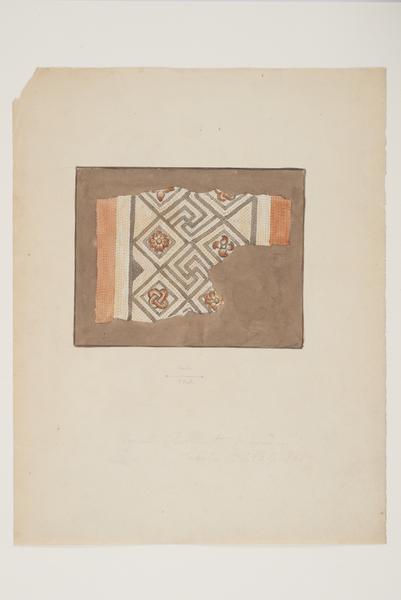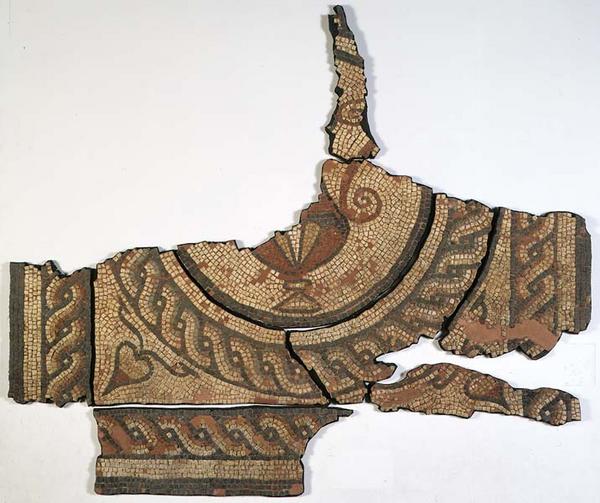The Roman mosaic that thrilled London
The Bucklersbury Pavement is an exquisite 2,000-year-old Roman floor mosaic discovered in central London. It was a sensation when it was found in 1869 and, safely stored in our collection, has remained one of the most important relics from Londinium.
Bucklersbury, City of London
200–250 CE
Tiny tiles from another time
Mosaics don’t only show off the Romans’ amazing building skills. They’re also a brilliant expression of their sophisticated culture.
Often, all we find is fragments. But the Bucklersbury Pavement is amazingly complete. Looking at it, you can almost hear the slap of the Roman sandals.
The mosaic dates from 200 to 250 CE and features a complicated design of interlocking squares, flowers and braids.
It was found during the construction of a new road in 1869 – a discovery that drew tens of thousands to see it. Since then, it’s been a precious part of our London Museum collection.
“as fresh and perfect as if but yesterday it had left the artist’s hands”
Illustrated London News, 29 May 1869
How was the mosaic discovered?
The mosaic floor was unearthed during the construction of Queen Victoria Street, which now runs through the City of London between Bank and Blackfriars.
It became known as the Bucklersbury Pavement because of its location – roughly midway between Poultry and Bucklersbury, close to Bank station and Mansion House. This area was in the heart of the fortified Roman settlement, which they called Londinium.
The discovery of the mosaic was reported by national newspapers and magazines. The Illustrated London News, writing on 29 May 1869, said that despite lying about 5 metres below the surface, “it is apparently as fresh and perfect as if but yesterday it had left the artist’s hands.”
The paper published a sketch of the scene. Temporary staging was built around the mosaic and more than 50,000 people came to see it.
When was the mosaic floor laid?
The Bucklersbury Pavement dates from between 200 and 250 CE.
Roman London was founded in 47 CE and then continued into the 400s. Mosaics were being laid in wealthy London houses right from the start.
What does the mosaic look like?
The Bucklersbury Pavement uses hundreds of black, blue, red and white tiles. It’s roughly 4.5 metres long and 2.5 metres wide.
It’s split into three sections. At the bottom is a roughly square section containing the mosaic’s most fascinating detail – two angled, interlocking squares with braided borders and a flower in the middle. These must have been extremely difficult to lay out.
This style was used in other parts of Britain, but only in the century after the Bucklersbury Pavement was laid. As a trading centre with connections to the continent, London was probably quicker to adopt trends from elsewhere in the Roman empire.
The top section is a semi-circle, divided from the square section by a narrow rectangular strip. This strip shows flowers winding and curling their way out of a pot.
Who built this mosaic?
The middle strip of this mosaic is our biggest clue. It features a plant with straight stems and short leaves, like those seen on an acanthus, a common shrub around the Mediterranean.
The acanthus design was the trademark of a Roman mosaic workshop active in London during the 3rd century CE. This group’s designs have been found elsewhere in the City of London, on mosaics at Lothbury and Leadenhall. A mosaic discovered in Southwark in 2022 – the largest found in London for 50 years – is also likely to have been their work.
The people who laid the finest mosaics were experts. They knew what designs were in fashion and sometimes travelled across the empire to work on projects.
What do we know about the building?
We don’t know who the mosaic was made for. In London, mosaics appeared in the homes of merchants and the highest levels of society, as well as large public buildings.
The Bucklersbury Pavement lay above a sophisticated underfloor heating system which used a network of channels to funnel hot air from a furnace. These heating systems are found in Roman baths as well as homes. The mosaic’s foundations were clearly very well built for it to have survived so long.

This plan shows the underfloor heating system.
The shape of the mosaic suggests that the room was laid out in two parts: a square area and a semi-circular end. The rectangular panel with the acanthus plant marked the threshold between these two parts. There may have been columns on either side of this section, supporting an arch or a pediment, a triangular feature which supports the roof.
We suspect this room may have been used for entertaining. It was part of a building that faced onto a road about 10 metres to the south.
Compared to other Roman towns in Britain, space was limited in London. This was a tightly packed commercial hub, and archaeologists haven’t found the same large, luxurious townhouses as they do elsewhere.
Still, London was home to one of the largest mosaics ever to have existed in Roman Britain. The pavement found in Old Broad Street in 1854 measured over 49 sq metres. Now known only from drawings made at the time of discovery, its centrepiece was apparently a naked figure reclining on an animal. It was also one of the last mosaics to have been laid, dating to some time after 350 CE.






